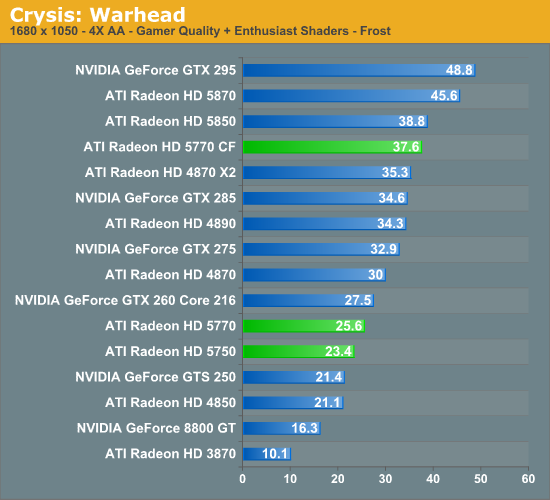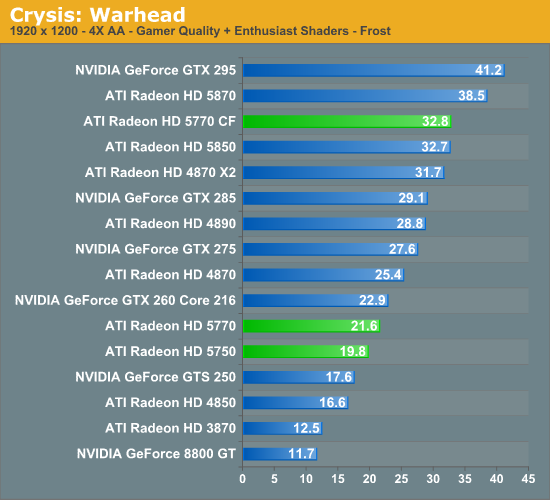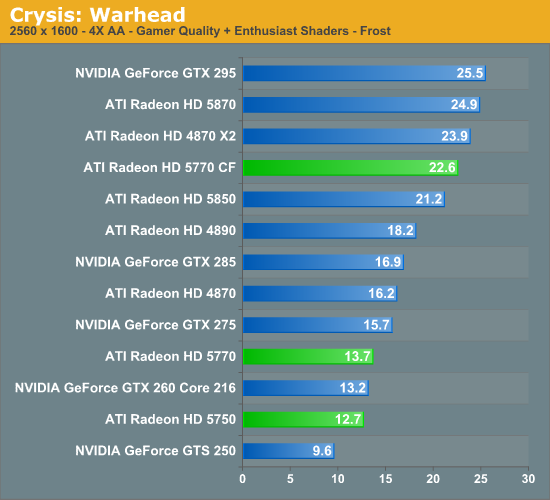AMD’s Radeon HD 5770 & 5750: DirectX 11 for the Mainstream Crowd
by Ryan Smith on October 13, 2009 12:00 AM EST- Posted in
- GPUs
Crysis: Warhead
Kicking things off, we’ll start with Crysis: Warhead. Warhead is still the single most demanding game in our arsenal, with cards continuing to struggle to put out a playable frame rate with everything turned up.



Update: As a few of you pointed out, there was something a bit off with our Crysis results; we had a Radeon 4850 beating the 5770. As it turns out we wrote down the maximum framerate for the 4850 instead of the average framerate. None of the other results were affected, and this has been corrected. Sorry, folks.
There are a few different situations we’re going to be interested in. The first is the matchup between the 5770, the 4870, and the GTX 260. The second is the matchup between the 5750, the 4850, and the GTS 250. The third is the 5770 as compared to the 5800 series, in order to see what another $100 or $200 is buying you in the Evergreen family.
Unfortunate for the 5770, this is not a game that treats it well. In spite of the clock speed advantage over the 4870, and the architectural advantages (extra caches and what-not), it underperforms the 4870 by about 15% here. AMD had once told us that they believed that they weren’t memory bandwidth constrained on the 4870/4890, but when that’s the only significant difference between the 5770 and the 4870 that would explain the performance difference (certainly Juniper wouldn’t be slower than RV770), we are beginning to doubt that. Meanwhile the GTX 260 outscores the 5770 here too.
Looking at the 5770 compared to the 5850, $100 buys you roughly 50% more performance.
The 5750 fares much better here. It beats the 4850 by 10%-20%, and beats the GTS 250 by a similar margin.










117 Comments
View All Comments
Spoelie - Tuesday, October 13, 2009 - link
The difference is obviously the memory bandwidth. It seems to me that ATi should have gone with a 192bit bus, this change alone would have made the HD57x0 a worthy successor to the HD48x0 range, without any performance caveats, while still being significantly cheaper to manufacture (40nm vs 55nm, 192bit vs 256bit).Skiprudder - Tuesday, October 13, 2009 - link
I'm guessing your right, but I'd like to see Anand (or Ryan) do one of the track-down-the-engineers that this site is famous for, and hear the rational on AMD's part.CarrellK - Wednesday, October 14, 2009 - link
Anand knows where I live...CarrellK
futrtrubl - Tuesday, October 13, 2009 - link
Or even just overclock the memory and see how performance scales. That would provide some evidence for the memory bottleneck theory.plague911 - Tuesday, October 13, 2009 - link
At this price point it looks like the 5770 & 5750 are priced to pad AMD's pockets, not to provide increase performance (not that, that's a bad thing when in a war with Intel). With the smaller process size and smaller chip size and similar performance each new part sold will net AMD a substantialy higher profit. This is why AMD will likely kill off the older gen instead of droping the price point.MadMan007 - Tuesday, October 13, 2009 - link
Yes I think that's where my mild disappointment comes from. Not that they aren't great cards for the launch MSRP, they just aren't great in light of street prices, but unlike HD4800 or even arguably HD5800 AMD doesn't seem interesting in shifting the price/performance curve with these cards. At best matching the current price/performance curve leaves me a bit cold.MonkeyPaw - Tuesday, October 13, 2009 - link
That's been the trend from ATI lately with their mid-grade cards. The 5700 series is meant to offer roughly the same performance of the 4800 series for a cheaper price. The 4600 series last time was meant to match the 3800 series (the 4770 was quite an oddball though). It's not a bad system, really, as it allows ATI to migrate their lineup with some consistency.Lonyo - Tuesday, October 13, 2009 - link
It might be that some of the cost does indeed come from the RAM though.Once GDDR5 chips drop some more, it will be easy for AMD to drop the prices on these cards, but that might (might) be what's limiting pricing options.
Or AMD just want to try and get maximum profit from these cards.
But even so, when GDDR5 prices drop it will be easier to extract profit at lower prices, so GDDR5 pricing will still be at least partly responsible.
geok1ng - Tuesday, October 13, 2009 - link
Reading the charts it gets obvious that it is upgrade time: lets get 4850s, 4870s, and even 4850X2-4870X2 on the next weeks before these cards phase out: they are faster and a LOT cheaper than the 57xx series. As for the high end consumers, just wait for the 5870X2, now that is a card to roll eyes, when and IF it launches.codedivine - Tuesday, October 13, 2009 - link
This is relevant only for compute folks like me, but does 57xx support double precision?